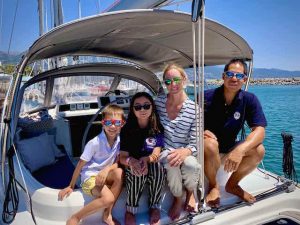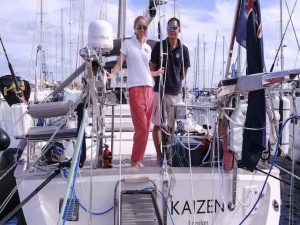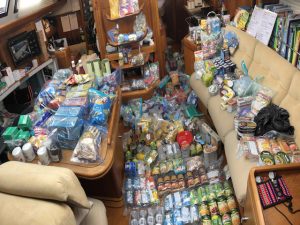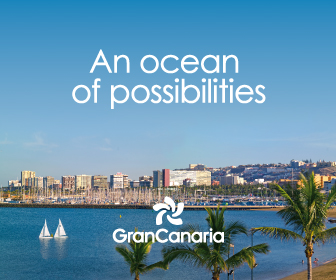Bluewater Cruising: Family Boat Shares Top Tips
Taking part in their first ARC in 2020, Kean and Nyree Chung purchased Kaizen, an Oyster 49 in 2017 and will be sailing with their two children, aged 11 and 7. Once in the Caribbean, the family will circumnavigate with the World ARC starting from Saint Lucia in January 2021. Here, they share their practical advice for anyone preparing and planning their own blue-water adventure.
Published 4 years ago


1. Know your boat
Many people buy brand new boats. However, they may not have had sufficient time, nor experienced enough challenging conditions, to really test the boat properly. Owners should know where all the plumbing, wiring, fuses and circuit breakers are; as well as knowing how she sails and reacts in different conditions.
2. Safety
Every boat is different. Set up your jackstays and formulate your safety procedures. Document them in a checklist that can be easily referred to in a panic moment. Practice them with the crew and family before getting anywhere near Las Palmas. The passage down to the Canaries can be substantially more lively than the Atlantic crossing itself!
3. Family boats
Make sure your children know that they are part of the crew rather than a passenger. That they will be given responsibilities suitable to their age and ability. Talk to your children as adults so that they understand that on the boat if you say “you can’t run”, it’s because it’s potentially dangerous and that they have to respect that. Once they are on the boat, if the captain says something, then that’s final.
4. Anchoring or mooring
This can be stressful for the parents who might be shorthanded. “We introduced a code word ‘Station’,” says Nyree. “When we say ‘Station’, it means the children sit still and don’t speak. It’s not a good time to start asking for help with Lego or having a fight with your brother! This has been engrained into them from an early age.”


This can include looking at almost everything on board the boat. For example, making sure you have good water. “On our boat it either comes from a water maker or dock tap,” explains Kean. “From a dock tap it gets filtered to remove all the chloride and sediment and it passes through a water softener. We only drink water from the tank so that we don’t generate plastic waste. For our hot water we experimented with different things. We started off with a kettle like everybody else but felt that could be dangerous at sea. We then moved onto an electric hot water urn and found that was a tricky having to refill it every day. So now we have an instant hot water tap. Our drinking water tap goes through three filters from a filter manufacturer that makes filters for industry and medical companies. This removes all traces of bacteria and harmful elements before going through a remineralisation cartridge which puts back the essential minerals that we need to live. For sparkling water, we use a Soda Stream. However, we’ll be going to remote parts of the world where it’s difficult to find replacement Soda Stream gas canisters. So we bought an adapter that will allow us to fill our used canisters from any restaurant or bar that pumps soft drinks and beer out of a tap.”
6. Medical kit
It’s important to sign up to a great tele-med service and then purchase all the recommended kit. “Our kit includes things that I hope we never need to use, like a bone injector because we were told that trying to insert a needle on a rocking boat could be really tricky. Test the tele-med service before departing. Find something mild to call up about to see how it works. It’s an unlimited package anyway so you want to know what the procedure is like. Try everything beforehand, not whilst you are at sea in a stressful situation.
7. Prior preparation
It’s all about preparation. Carry plenty of critical spares. A spare complete autopilot is extremely important; especially if you are shorthanded. When you purchase spares, install the new one well ahead of time and keep the old as a spare. You’ll then know your spare works and you are also covered by the new warranty. It’s too late to be swapping out critical parts in Las Palmas. You don’t want to be using untested kit like a water maker on your Atlantic crossing.
8. Onboard schooling
I’d recommend you start the schooling process before you set off on the boat. Your child then has time to get used to the new programme and accept the new role of the parent becoming the teacher. Once you are on the boat you are so busy and you want to try and avoid as much stress as you can. Also be realistic about how much schooling you need to do. Sailing is an amazing opportunity to explore interesting places, meet new cultures and try different languages – so get out there, don’t spend all day behind a book. And remember, boat-schooling doesn’t need to be in the boat. My kids often do their work in a restaurant or back of a hire car. Maximise your time. My children only do book work for English, Maths and Science. History, Geology and Geography are done in the field, learning in context of where we are that day. On a passage or a rainy day, we might do a lot of work and other days we simply play on the beach. There is no such thing as a nine to five day or a weekend off once you are sailing. Be adaptable.
9. Preventative maintenance
Many boaters wait until something breaks before they fix it. If you are going to be crossing oceans and sailing into remote parts of the world, you should think about preventative maintenance and have everything on a schedule to check and replace. For example, we will replace our toilet macerator pumps at certain regular intervals. We haven’t had any plumbing issues on this boat over past four years. Think ahead. Spending the money now to replace a part where the chandleries are convenient and labour is skilled is much better than having to have a part shipped out to Tahiti or Fiji where the postage cost could be multiples of the part. Get ahead of the curve.
10. Communications on board
We subscribe to both Iridium and Inmarsat Fleet One. Our Iridium Go is on an unlimited data plan and we do all our routine communications like emails and weather on that. Our faster Fleet One, where we pay per megabyte, we use for things like WhatsApp as our primary means of communicating with family as well as to send and receive larger emails with attachments. We also have Inmarsat-C which is slightly unusual for a cruising boat as they are usually on commercial boats. That will give us access to SafetyNet service that provide us with navigation and weather warnings for the high seas. We have that delivered to us twice a day.
11. Training
“Five years ago when we had the idea to do this, I had never really spent much time on a boat before, so I have gone from being a novice sailor and now I have my Day Skipper,” says Nyree. “Don’t put all of the ownership onto one person because they could get ill or you might think you are going to have crew, but as we’ve seen with Covid, you never know what’s going to happen. Do the training early because if you’ve left it to the last minute you might not get a training course in time. Start thinking early and map out what you want and what needs to be done. You can pass your RYA Competent Crew from the age of 11 officially, but our daughter passed it when she was 10!”


We’ve been provisioning now all the way down from Greece. We bought olives and olive oil in Greece, pasta and salami in Italy, plus we caught a lot of tuna along the way. We are fortunate to have a big freezer and fridge. If you are going to buy meat, like the wonderful ham here in Spain, make sure that you buy the items with the furthest best before date. Stock up as you go along, as each country has its speciality foods. In Gibraltar, we stocked the freezer with English back bacon, black pudding and proper English sausages. We are fully stocked now – probably until the South Pacific.
Don’t buy food that you wouldn’t usually eat at home as you probably won’t eat it on the boat either. Produce like UHT milk can be purchased in most places in the world. There are specific things that certain countries offer that you really can’t get in other more remote places. The French are particularly good at tinned and jars of vegetables, so stock up those in French territory before you come to the Canaries.
13. Fishing – know your gear
“We spent three years in the Med only having caught one fish. We were always of the belief that there were no fish there! During lockdown we got all our boat jobs done so we had quite a bit of spare time and decided to put our minds to fishing. Ever since we changed our tactics, we’ve been catching so many fish that we’ve had to put the lines away because our freezer is full,” says Kean.
Tips include: Knowing your gear. You should know what the breaking strain of your line is and where that is in relation to your drag setting. You should also know how much the rod bends at different loads. If you hooked a fish, that’s half of it and the other half is landing it. You don’t want to put on too much or too little drag. We’ve also started using fluorocarbon leaders because it is invisible to fish under water. We fish four lines and at different depths to maximise the probability of attracting and catching fish. Our biggest secret is setting up multiple lures so it looks like there’s a chase going on. We will have some bigger lures behind chasing some smaller lures closest to the boat. We’ve been consistently catching fish ever since. We lost a huge marlin the other day on our way from Tenerife to Gran Canaria.
14. Key Words
We’ve got three key words:
One is ‘Station’ as mentioned above.
The second is ‘Fish on’ for when we hear the whizz of the fishing line being spun out. Everyone onboard stops what they are doing immediately and gets into position in whichever role they have. We are now so well practised at our roles when we catch a fish, that it is has become routine. My son goes on watch, my daughter helps my husband put on his fish fighting harness and then slows down the boat. She then acts as the photographer or videographer. I take in all the spare lines whilst my husband fights the fish. Spend money on good fishing gear because it really pays off on the long run. If you buy the best, you only need to buy it once in your life. Really good reels will last a lifetime.
Our third word or phrase rather is ‘man over-board’. This is not only for when we are sailing but also in the marina. Both our children have fallen into the water – one from the boat and one from a pontoon. It is a surprisingly common and yet overlooked experience. Having a procedure in place in advance results in a quicker, more effective response and therefore a better outcome for the family.
Kean and Nyree Chung
SY Kaizen
…………………………………………………………………………………………………………………………………..
Related Articles and Links:
- Noonsite’s Cruising Information page (with planning and preparation section)
- Noonsite’s Cruising with Children page
- INSIGHTS: Boatschooling – Ages 4 to 12
- ARC 2020
…………………………………………………………………………………………………………………………………..
The opinions expressed in this article are the author’s own and do not reflect the view of Noonsite.com or World Cruising Club.
Related to following destinations: Canary Islands, Gran Canaria, Las Palmas de Gran Canaria, Rodney Bay, St. Lucia
Related to the following Cruising Resources: Atlantic Crossing, Circumnavigation, Circumnavigation, Communications, Communications Equipment, Cruising Information, Cruising with Children, Planning and Preparation, Routing








